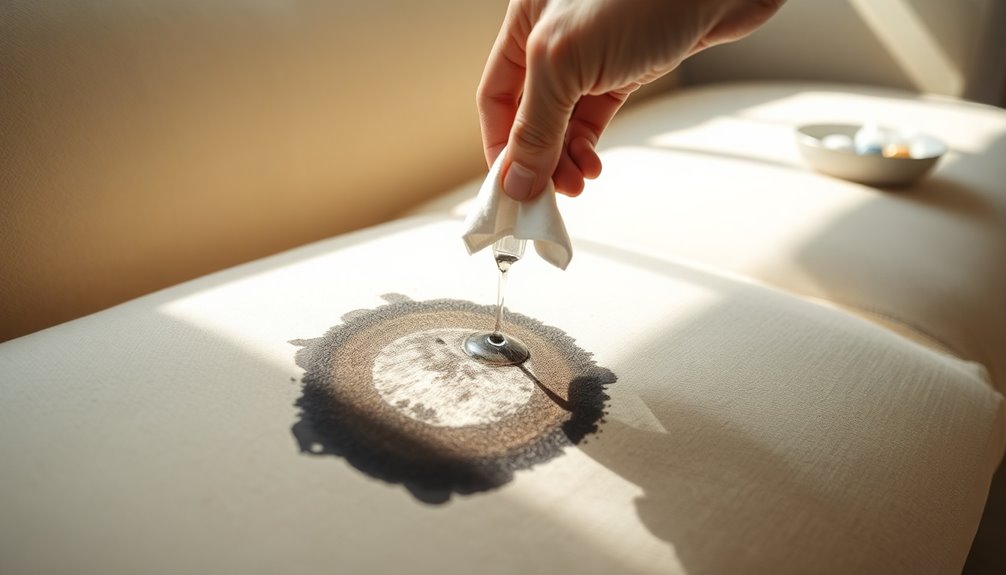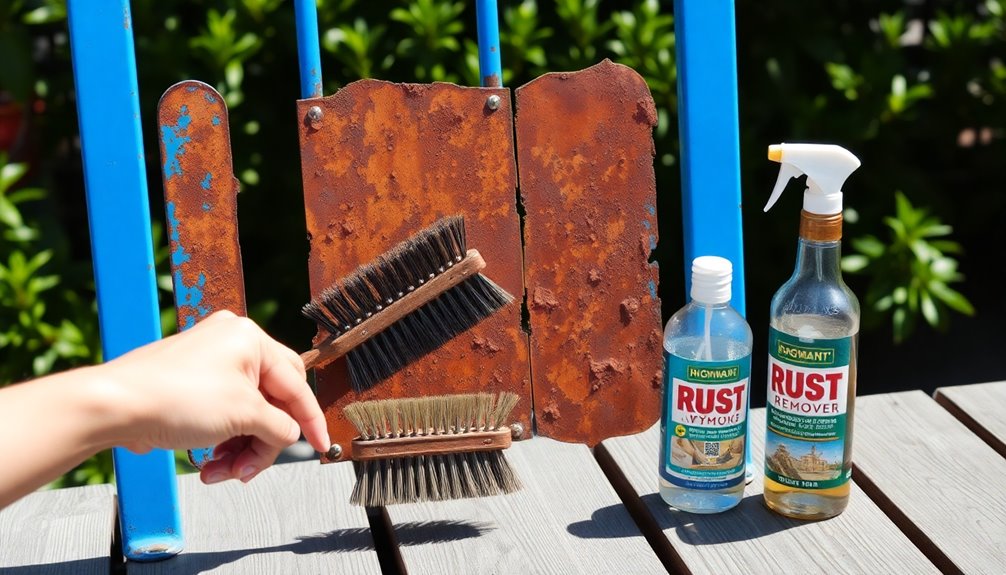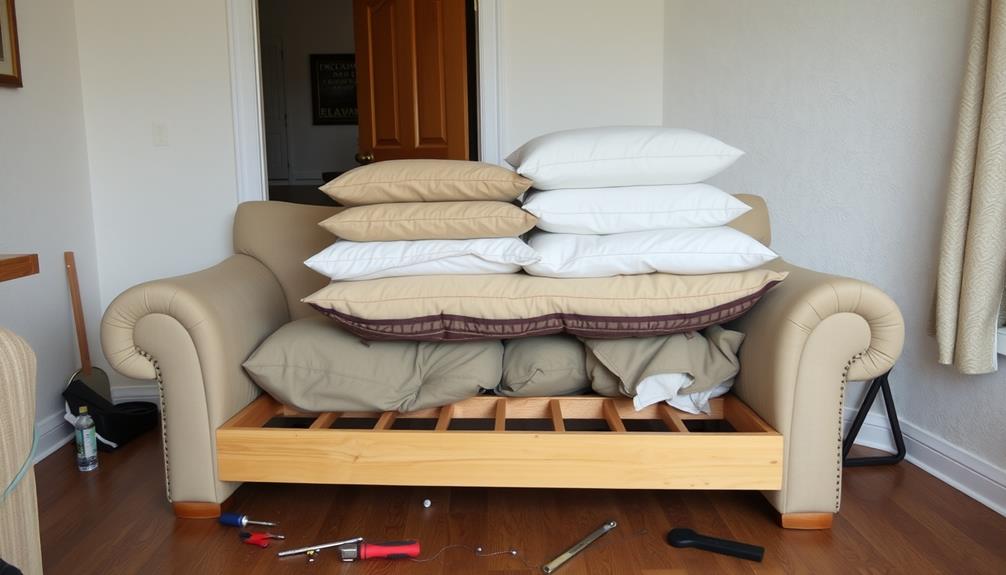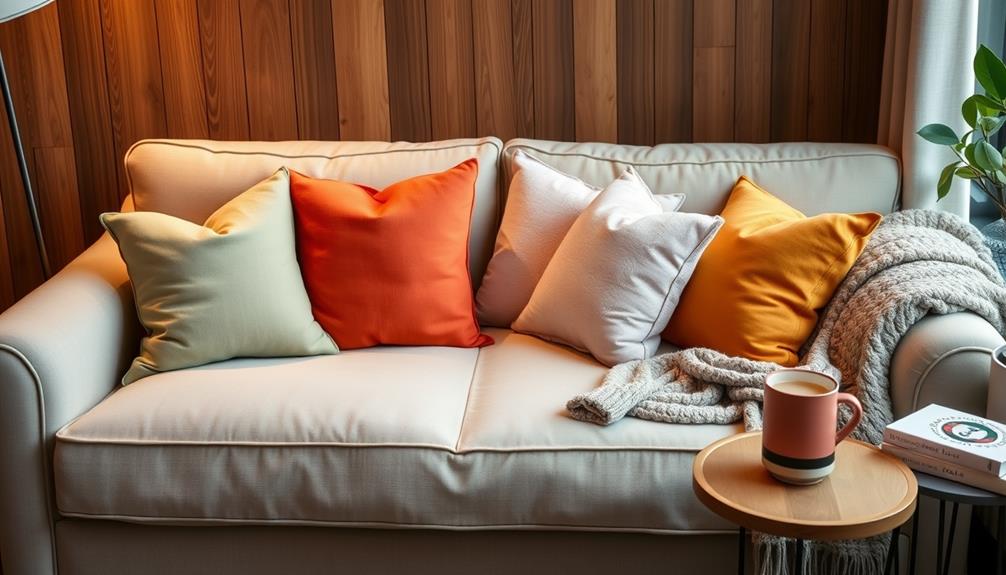To get biro out of your sofa, act quickly. First, blot the stain with a clean cloth to absorb excess ink—don't rub, as it can spread. Use a cloth dampened with rubbing alcohol or a mix of dish soap and water, and gently blot the stained area. Rinse the cloth frequently to avoid reapplying ink. Always test any cleaning solution on a hidden spot first to check for compatibility. With prompt action and the right techniques, you can effectively remove that stain while preserving your sofa's beauty. There's plenty more helpful advice on keeping your furniture looking fresh.
Key Takeaways
- Blot the ink stain immediately with a clean cloth to absorb excess ink without spreading it further.
- Identify the fabric's cleaning code (W, S, S-W, X) to choose the appropriate cleaning solution for your sofa.
- Use rubbing alcohol on a cloth to gently dab the ink stain, working from the outside in to lift the ink.
- Test any cleaning solution on a hidden area of the fabric to ensure it won't cause damage or discoloration.
- After cleaning, check the area for any remaining ink and repeat the process as necessary for complete removal.
Introduction
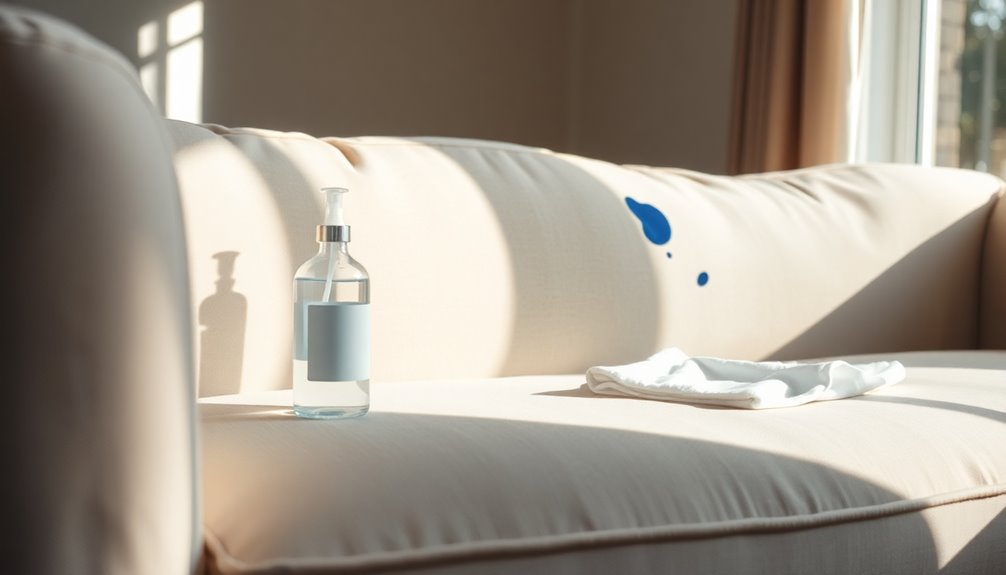
When it comes to keeping your sofa looking fresh, routine fabric protection techniques are a must. Knowing fabric-specific cleaning methods can save you from damaging your upholstery, especially when tackling stains like biro or wine. Let's explore effective solutions that will help you maintain your sofa's appearance and longevity.
Routine Fabric Protection Techniques
Protecting your sofa fabric is essential for maintaining its appearance and longevity. Regularly applying a fabric protector can create a barrier against stains, making it easier to clean spills and marks like biro ink. To keep your sofa looking its best, incorporate routine maintenance into your cleaning routine. This includes vacuuming regularly to remove dirt and debris that can settle into the fabric, reducing the chance of permanent stains.
Using a lint roller or brush is also effective for removing surface dust and pet hair, which can lead to discoloration over time. Don't forget to perform a deep clean of your sofa every six to twelve months. This helps maintain its appearance and prevents the buildup of stains and odors that can arise from neglect.
Always refer to the manufacturer's care instructions for your specific sofa fabric. Following these guidelines ensures that the protection methods you use are both safe and effective. By committing to these routine maintenance techniques, you'll significantly enhance the longevity of your sofa and keep it looking fresh for years to come.
Fabric-Specific Cleaning Techniques
Understanding the specific cleaning techniques for your sofa fabric can make all the difference in effectively removing stains like biro ink. First, identify the cleaning code on your sofa. This code reveals the suitable methods for your fabric type: W for water-based solutions, S for solvent-only options, and S-W for either.
For fabrics like cotton and polyester, a mixture of dishwashing detergent and vinegar works wonders to remove ink stains. However, more delicate materials may need gentler solutions. Always test any cleaning solution on a hidden area of the sofa to avoid damaging or discoloring the fabric.
If you're facing tougher stains from ballpoint pens, rubbing alcohol is a reliable choice as it breaks down the ink without harming most upholstery. For leather sofas, you can use a combination of white vinegar and dish soap. Just remember to opt for products specifically designed for leather care to maintain its integrity. Maintaining a clean home supports a healthier lifestyle by promoting cleanliness and hygiene.
Ink and Wine Stain Solutions
Ink and wine stains can be a homeowner's nightmare, but quick action can save your sofa from lasting damage. When dealing with an ink stain, the first step is to gently blot the area with a clean cloth. This helps lift the ink before it sets into the fabric. For water-based ink stains, mix one tablespoon of dish soap with two teaspoons of white vinegar and warm water. Apply this solution to the stain and blot it until the ink starts to lift.
If you're dealing with solvent-based ink, rubbing alcohol is your best bet. Dab some onto a cloth and gently press it against the stain. Always remember to test any cleaning solution on a hidden area of your sofa first to ensure it won't damage the fabric.
When it comes to wine stains, act fast! Blot the area to absorb as much liquid as possible, then use club soda or a mixture of dish soap and white vinegar to treat the stain. Whether it's ink or wine, immediate action and the right cleaning solutions can help restore your sofa to its former glory.
Stain-Resistant Fabric Treatments
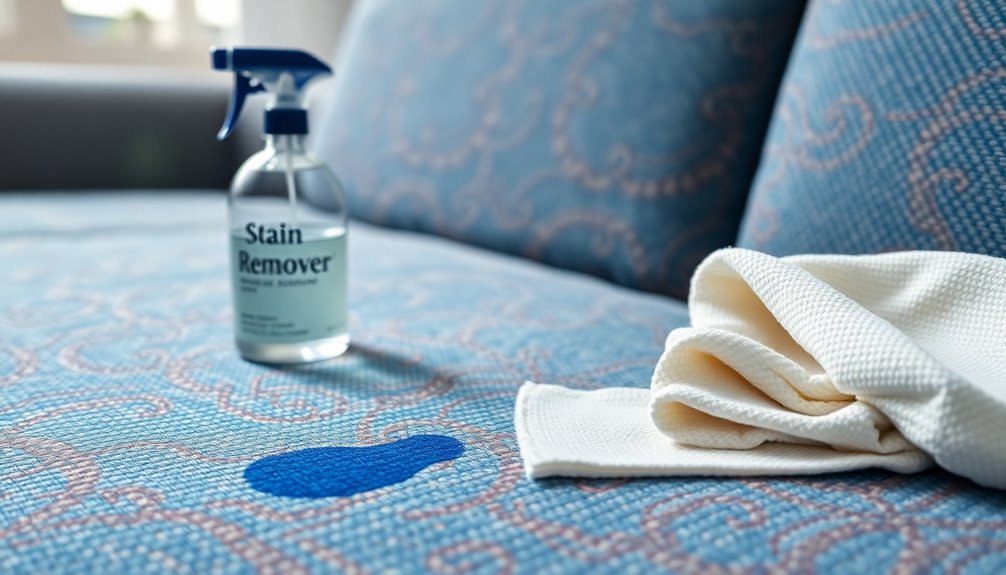
When choosing upholstery, consider scratch-resistant fabric options that can withstand daily wear. Protective fabric layers not only guard against stains but also help minimize friction, prolonging the life of your furniture. By investing in these features, you'll make cleaning up spills like biro ink a whole lot easier. Additionally, selecting materials that incorporate sustainable decor practices can contribute to a healthier home environment.
Scratch-Resistant Fabric Options
If you've got kids or pets, choosing scratch-resistant fabric options for your sofa can be a game-changer. These fabrics often come with specialized coatings that enhance durability and prevent abrasions, making them ideal for busy households. Look for upholstery made with high-twist yarns, which provide extra strength against snags and scratches, ensuring your sofa stays looking new.
When shopping, pay attention to the rub count rating. Fabrics rated at 30,000 rubs or more indicate superior wear resistance, making them capable of withstanding everyday use without showing signs of wear. Alongside scratch resistance, consider stain-resistant treatments like Teflon or Scotchgard that repel liquids and prevent stains from penetrating fibers.
Maintaining your sofa's protective properties is essential. Regular cleaning keeps both scratch-resistant and stain-treated fabrics looking fresh. For stubborn stains, a gentle solution of rubbing alcohol can help, but always test it on a hidden area first. By choosing the right fabric and caring for it properly, you can extend the life of your sofa, keeping it comfortable and stylish for years to come. Additionally, selecting fabrics with high-twist yarns can further enhance your sofa's resilience against wear and tear.
Protective Fabric Layers
Protecting your sofa from stains can be a worthwhile investment, especially with kids or pets around. One effective way to do this is by utilizing protective fabric layers. Many modern sofas come with pre-treated fabrics designed to repel liquids, which can help you clean up spills before they turn into stubborn stains. These stain-resistant treatments often use advanced technologies like Teflon or Scotchgard, creating a barrier that protects against ink stains, including biro, while still allowing the fabric to breathe.
To maximize your sofa's resistance to stains, consider regularly applying a stain-resistant spray. This will enhance the protective qualities of your sofa's fabric, giving you an extra layer of defense against unexpected messes. Just remember to follow the manufacturer's care instructions when applying these protective fabric layers, as improper use could compromise the fabric's integrity and warranty. Additionally, understanding the importance of stain-resistant treatments can help you make informed choices in maintaining your furniture.
Minimizing Fabric Friction
Minimizing fabric friction is crucial for maintaining the appearance and longevity of your sofa. One effective way to achieve this is through stain-resistant fabric treatments. These treatments create a protective barrier on the fibers, significantly reducing ink absorption and making it easier to clean up spills like biro stains.
Stain-resistant treatments often feature chemical coatings that repel moisture and stains, preventing permanent marks on your upholstery. By applying these treatments regularly, you can extend your sofa's life, minimizing damage from spills and everyday wear. Some stain-resistant fabrics are specifically engineered to withstand friction, which means they're less likely to stain due to frequent use and contact.
When using stain-resistant fabric treatments, it's essential to follow the manufacturer's guidelines. This ensures you don't compromise the fabric's integrity or warranty. Additionally, maintaining good indoor air quality with air purifiers can further protect your furnishings from pollutants that may contribute to stains. By investing in these treatments, not only do you protect your sofa from unsightly stains, but you also keep it looking fresh and new for years to come. Whether you're dealing with kids, pets, or just daily life, stain-resistant fabric treatments are a smart choice for anyone looking to reduce fabric friction effectively.
Fabric Condition Assessment
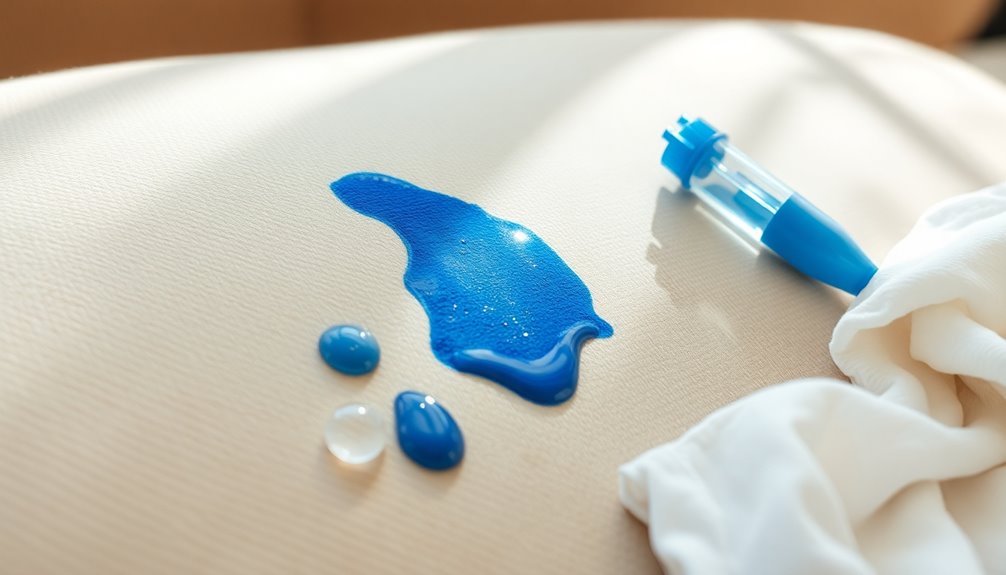
Before you tackle that biro stain, check the overall condition of your sofa's fabric. Look for any signs of wear or damage that could affect not just the cleaning process, but also the integrity of the frame and the softness of the fabric. Assessing these factors will help you choose the right approach for revitalizing your upholstery.
Frame Integrity Concerns
Understanding your sofa's fabric condition is crucial for effective cleaning, especially when dealing with stubborn stains like biro ink. Start by inspecting for any tears, fraying, or discoloration that might complicate the cleaning process. Damage to the fabric can worsen if the cleaning method isn't appropriate, so check the cleaning code on your sofa. This code will guide you to the right cleaning solution—whether it's water-based or solvent-based.
Next, consider the age and size of the stain. Older or larger stains often need more intensive cleaning techniques, which may require professional help to avoid fabric degradation. However, don't overlook frame integrity concerns. A weakened frame or cushioning can significantly affect both the cleaning outcome and the longevity of your fabric. If the structure isn't sound, even the best cleaning efforts may fall short.
Regularly assessing your sofa's fabric condition and addressing any issues promptly can help maintain its appearance and durability against future stains. By being proactive, you'll ensure that your sofa remains a beautiful and functional part of your home.
Fabric and Leather Revitalization
Assessing your sofa's fabric and leather condition plays a key role in revitalization efforts. Start by identifying the type of fabric your sofa has; knowing this is crucial since different materials react differently to various cleaning solutions. For fabric sofas, locate the cleaning codes (W, S, S-W, X) to select the right method and avoid any damage during cleaning.
If your sofa is leather, you'll need specialized cleaning products designed for its unique texture and finish. Using leather-safe cleaners is essential to maintain the integrity of the material. Regularly conditioning both fabric and leather upholstery ensures they remain in good shape, helping to prevent stain absorption and making future cleaning easier. By understanding the condition of your sofa's fabric or leather, you can effectively choose the right cleaning solutions and techniques that yield the best results. This careful approach not only maintains the appearance of your sofa but also extends its lifespan.
Additionally, using appropriate cleaning techniques based on the fabric type can further enhance the sofa's longevity. Remember, a well-assessed and maintained sofa enhances your living space and keeps it looking fresh and inviting.
Revitalizing Fabric Softness
Regularly checking the fabric condition of your sofa is essential for keeping its softness intact. Start by examining the fabric type—whether it's microfiber, cotton, or polyester—as each has unique care requirements. Assess areas that may feel rough or have lost their plushness, and note where more attention is needed.
To maintain that softness, use cleaning solutions that are gentle and safe for your upholstery. Avoid harsh chemicals, as they can degrade the fabric over time. After cleaning, consider applying a fabric conditioner specifically designed for upholstery. A small amount of rubbing with the conditioner can help restore that soft feel, making your sofa cozy once again.
Additionally, schedule periodic deep cleaning sessions with professionals who specialize in upholstery care. They can effectively remove embedded dirt and stains that regular cleaning might miss, ensuring your sofa remains fresh and soft. Regular assessments and maintenance will ensure your sofa not only looks great but also feels inviting every time you sit down. By following these steps, you'll prolong the life of your sofa and enjoy its softness for years to come. Moreover, using gentle cleaning solutions can help prevent damage to the fabric and maintain its quality over time.
Fabric Color and Pattern Adjustments
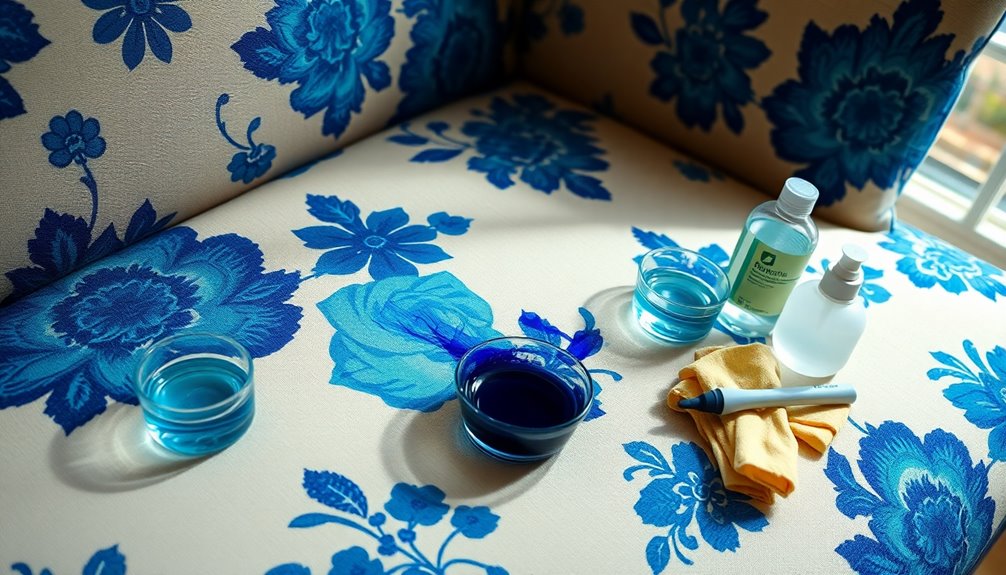
When cleaning a sofa with patterned or colored fabric, it's crucial to consider both the cleaning method and the fabric's characteristics to avoid damaging the design. Always check the cleaning code to ensure your chosen solution is compatible, as using the wrong method can lead to fading or even damage. For example, synthetic fabrics often handle certain stain removal techniques better than natural fibers, which can be more sensitive.
Before diving in, test any cleaning solution on a small, inconspicuous area. This way, you can see how the color and pattern react without risking the entire sofa. When it comes to applying the cleaning solution, use a clean cloth and a gentle blotting technique. Avoid vigorous scrubbing, as this can distort the design and worsen the issue. Take your time and be patient, allowing the cleaning solution to penetrate the fabric before dabbing it dry. Once you’ve finished cleaning, consider rearranging your living space for a fresh look. If you’re looking for inspiration to change up your decor, you might even explore how to rotate furniture in stardew valley for creative ideas!
Lastly, maintain a consistent cleaning approach across the entire sofa. This helps ensure a uniform appearance, especially with multi-colored fabrics. By following these tips, you'll keep your sofa looking fresh and vibrant, without compromising its unique design.
Ongoing Fabric Maintenance Tips
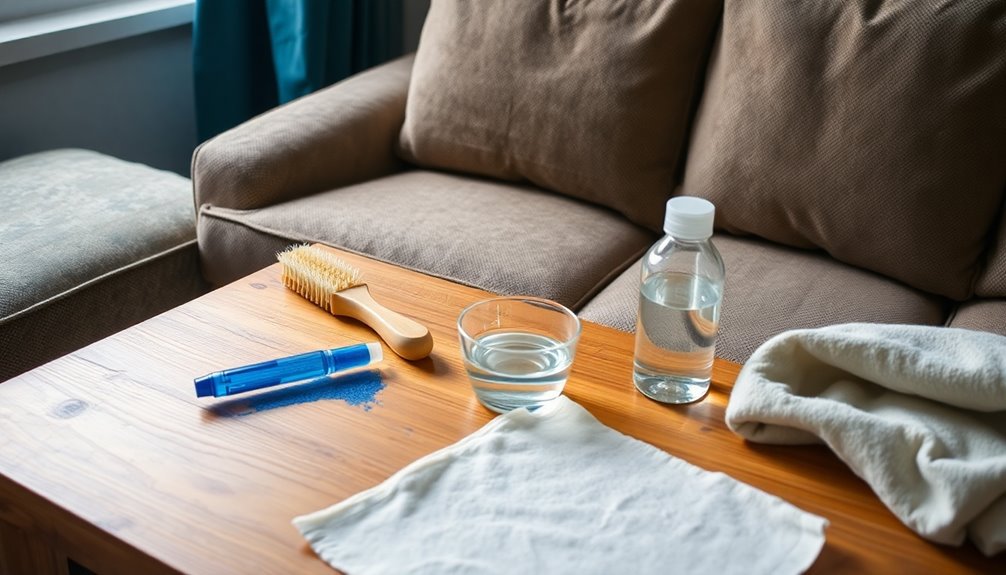
Keeping your sofa in top shape goes beyond just addressing immediate stains; ongoing maintenance is key to preserving its look and feel. Start by regularly vacuuming your sofa to remove dust and debris. This simple step will prevent stains from setting into the fabric, ensuring it stays fresh.
Next, consider applying a fabric protector spray designed for upholstery. This creates a barrier against spills and stains, enhancing your sofa's longevity. When a spill does happen, act quickly. Blot the area with a clean cloth to absorb as much liquid as possible before it penetrates the fabric. Rubbing can damage the fibers, so be gentle.
It's also wise to keep a stain removal kit handy. Include items like rubbing alcohol, dish soap, and white vinegar for quick responses to unexpected stains. Lastly, schedule professional upholstery cleaning every 12-18 months. This keeps your sofa looking its best and maintains the integrity of the fabric. With these ongoing maintenance tips, you can enjoy a clean, comfortable sofa for years to come.
Conclusion
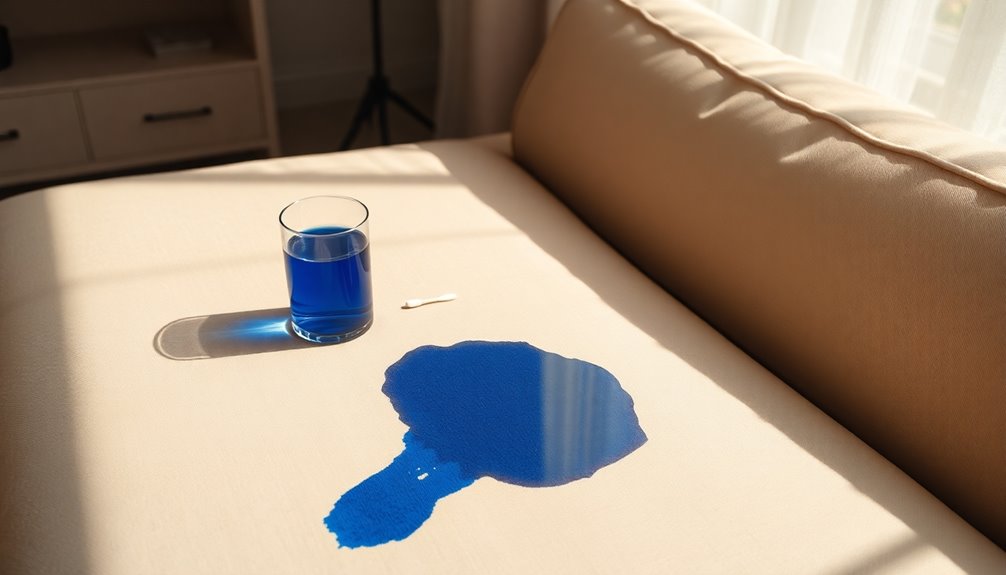
Your sofa's appearance and longevity depend on how you handle stains and maintenance. When it comes to pesky biro stains, quick action is key. The sooner you address the stain, the better your chances to remove an ink stain effectively. Always start by identifying your sofa's cleaning code to ensure you're using the right technique without risking damage.
For many fabrics, rubbing alcohol on a clean cloth can do wonders, but remember to test it on a hidden area first to avoid any discoloration. If the ink is water-based, a simple mixture of dish soap and vinegar works well on various fabric types, providing a gentle yet effective cleaning solution.
Don't underestimate the power of regular maintenance, either. Keeping your sofa clean and addressing spills promptly can significantly enhance its appearance and prevent stains from setting in permanently. By following these tips and acting quickly, you can maintain your sofa's beauty and extend its lifespan. So, don't wait—take action today to keep your sofa looking great!
Frequently Asked Questions
How Do You Remove Ballpoint Pen From Couch?
When you've got a ballpoint pen stain on your couch, start by blotting it with a clean, dry cloth to soak up as much ink as possible. Next, apply a small amount of rubbing alcohol to a fresh cloth and gently dab the stain. If that doesn't work, mix dishwashing detergent with white vinegar and warm water, then blot again. Rinse the area afterward and always test any solution on a hidden spot first.
How Do I Get Biro Out of Fabric?
To get biro out of fabric, start by blotting the stain with a clean cloth to absorb as much ink as you can. Then, apply rubbing alcohol to a fresh cloth and gently blot the stain from the edges inward. If that doesn't work, mix one tablespoon of dishwashing detergent with one tablespoon of white vinegar in two cups of warm water and dab the stain. Always test any solution on a hidden area first!
Does a Ballpoint Pen Come Out of Fabric?
Yes, a ballpoint pen can come out of fabric if you act quickly. Fresh stains are easier to treat than dried ones, so don't wait too long. Depending on the fabric type, you might need different cleaning solutions. Rubbing alcohol or a mix of dish soap and vinegar often works well. Always test any solution on a hidden area first. Remember to blot gently to avoid spreading the ink further into the fabric.
Will Magic Eraser Remove Ink From Couch?
Yes, a Magic Eraser can help remove ink from your couch, but it's not guaranteed to work on all fabrics or ink types. Start by testing it on a hidden area to ensure it won't damage the material. Dampen the Magic Eraser slightly, then gently rub the stained spot without applying too much pressure. Afterward, blot the area with a clean, dry cloth to soak up any residue and protect your couch.
